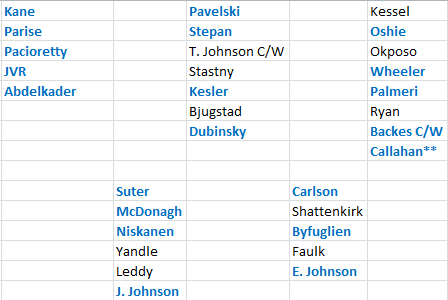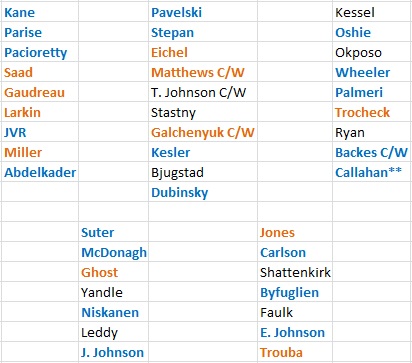It was the game that has spawned thousands of think pieces. As the US fell in uninspiring fashion to the Canadians last night, their World Cup failure raised questions about the team’s roster construction yet again.
While the 4-2 loss to Canada may have been expected, the previous shutout loss to Team Europe helped to stir memories of the pop-gun offensive efforts against Canada and Finland at the 2014 Sochi games. In fact, TJ Oshie’s goal late in the third period against Canada was the first scored by a US forward in 254:02; a streak that extends to Team USA’s preliminary round win against Slovenia in 2014. Only Ryan McDonagh’s goal against Canada kept that from being a shutout streak as well.
That is a stunning inability to score from a country seen as one of hockey’s super powers. Of course, the questions about the roster choices didn’t crop up over the past week. The choices made by USA Hockey have been questioned, in one way or another, since the original roster announcement earlier this year. Maybe this should be too surprising, as many of the same names criticized for questionable choices in 2014 – and highlighted by the in-depth, behind the scenes articles chronicling that team’s construction – remained part of the decision making process.
Favoring grit over skill is the most obvious and damning aspect of the roster USA Hockey built. Selecting a coach known more for encouraging blocking shots than scoring goals only perpetuated the inherent issues with the roster. The 2016 World Cup is a tournament of All Star teams and the US showed up with a roster featuring grinders and a proper fourth line. This probably stirs memories of quotes from Miracle about not needing the best players, only the right players. But the sad fact is that USA Hockey left a number of players at home who could have made a difference in this tournament.
Phil Kessel, Kevin Shattenkrik and Tyler Johnson were just a few of the big names who weren’t extended an invite to join Team USA in Toronto. The list of non-invites is fairly extensive and is only bolstered if you consider the young American stars playing for Team North America at the tournament.
Team USA was by far the team most negatively affected by the construction of the U23 North America squad. While there are a host of Canadian-born studs on the roster, Connor McDavid is likely the only player who would have found a home on Team Canada. Meanwhile, there are at least five players on the North American roster who would have otherwise been wearing red, white and blue this week.
However, even with Jack Eichel, Auston Matthews, Brandon Saad, Seth Jones and Shayne Gostisbehere absent from selection, that doesn’t excuse why the US management group felt it was so important to favor a grittier lineup. While there’s no arguing those five players would have been serious contributors for the Americans, the same could be said of Kessel, Johnson, Kyle Okposo, Bobby Ryan, Paul Stastny, Shattenkirk, Justin Faulk or Keith Yandle. Of those eight names there surely should have been a spot on Team USA in favor of Justin Abdelkader, Jack Johnson and Brandon Dubinksy, no?
Simply ignoring the fact that Team USA was severely hampered by Team North America is foolhardy. But saying Team USA’s failures are only as a result of the U23 roster is a far worse crime, as it only helps to reinforce the antiquated decisions made by the management group.
Some of this thinking is almost certainly born from the success the US had behind Ryan Miller and a well-rounded lineup in 2010. There are plenty of familiar faces on this year’s World Cup roster from the one that won silver in Vancouver. Only, many of the players who starred in 2010 have the heavy miles of six additional NHL seasons (well, five and a half thanks to the lockout) on their bodies.
Fast forward six seasons where the Canadian roster is only deeper with elite offensive players, the idea of combating them with a heavy lineup seems incredibly backwards. The US certainly doesn’t have the same offensive talent to fight fire with fire, but to select players who are simply over their heads skill-wise only served to limit Team USA’s ability to counter-punch and produce offensively.
Only a few simple changes may have given the US a far more potent roster for the World Cup. Perhaps they wouldn’t have beaten Canada, or even Sweden in the crossover game, but they would have almost certainly advanced past the group stage. Below is a rough depth chart featuring players who were and weren’t selected by the US for the World Cup which should help to illustrate some of the misses from the organizing committee.

That list could probably be expanded in some areas depending on how liberal you wish to be with player evaluations, especially on the wings. Still, adding Tyler Johnson, Paul Stastny, Phil Kessel and Kyle Okposo almost automatically makes this team more of a contender, no? The defacto top line of Kane-Pavelski-Parise could remain together while Stepan and Johnson could center a combination of Pacioretty, Okposo, Kessel and Oshie, creating three full lines capable of scoring. Personally, I’d still keep Kesler on the roster to combine with Stastny as a pair of defensively responsible bodies for the fourth line. Blake Wheeler and Backes would be my final two forwards as a line of Backes-Stastny-Kesler can check an opponent’s top line and wouldn’t be completely helpless in the offensive zone. However, Wheeler would get first run for me in most, if not every game simply due to his skating and all-around ability.
It’s worth noting that the US doesn’t have the advantage that Canada does when it comes to filling out their third and fourth lines. Canada can dip into their seemingly endless pool of stars and pluck a handful of 20-plus goal scorers who also happen to be phenomenal defensive players. The US doesn’t have the luxury of rostering Jonathan Toews, Patrice Bergeron, Brad Marchand and Ryan O’Reilly (albeit due to injury) without seeing any sort of drop off in talent. However, the American talent pool is certainly deep enough that the management team can do better than the likes of Dubinksy and Abdelkader when it comes to finding a mix of two-way talent and pure scorers.
The blue line falls almost perfectly from that chart. Suter, McDonagh and Niskanen are all solid on the left and Shattenkirk is such an obvious choice on the right I’m still amazed he was passed over. Add Justin Faulk as the extra defenseman and watch the powerplay be that much more effective with Shattenkirk, Faulk and Byfuglien to choose from.
This practice is more fun if you include the eligible players from the U23 squad into the mix. It’s a little more difficult to decide who you want to include and leave off from this list compared to the one above.

My roster would keep Kane-Pavelski-Parise together with a middle six consisting of Saad-Johnson-Gaudreau, Matthews-Eichel-Oshie with a fourth line of Stastny-Stepan-Wheeler because going forward without anyone who normally kills penalties or can match an opponent’s top line would be harmful in the long run. Pick your poison for the extra forward, whether that’s Kessel or someone who maybe offers more two-way capability. I personally like Pacioretty for that spot although grabbing someone who is more of a specialist might make the most sense. On defense I’d just run down the list again: Suter, McDonagh, Gostisbehere, Jones, Carlson, Shattenkirk and Byfuglien. That provides some very adept puck movers and at least two pairs who can legitimately match the fire power of other teams in a tournament.
There are about 101 ways to fill out a dream team when you factor in the U23s and it goes to show how the US were affected by the inclusion of Team North America. With or without those players two tough questions still exist. Does the management team have the faith to take more skilled players, particularly those from the U23 team? Would John Tortorella use these players effectively?
Those questions are really the underlying issue here. It’s not so much that the US doesn’t have talent but that the decision makers are clinging to some grit-and-heart focused fallacy which has damned the last two iterations of Team USA they’ve put out. The adage of leading a horse to water certainly applies here. If you gave Tortorella a roster minus Dubinsky and Abdelkader would he properly utilize Kessel and Johnson? Or would he still be beating the compete drum? It’s hard to say, even in hindsight. After all, putting Abdelkader with Kane was nothing but a ruse from Tortorella heading into the game against Canada. Ultimately it seems like the larger issue lies with the people choosing the team and less so with the man coaching the team.
With all the talk about creating the right identity and building a team that was more or less built to try and neutralize Canada’s biggest guns in hopes to scraping out a win, Team USA’s management team only succeeded in harming the US’s international hockey identity.
This should act as a clarion call to try and pick a roster that can run punch-for-punch with the Canadians. Rather, it’s time for USA Hockey to stop clinging to the success of 1996 (and 2010 in a lesser sense) and realize the younger talent at their disposal.
Add The Sports Daily to your Google News Feed!